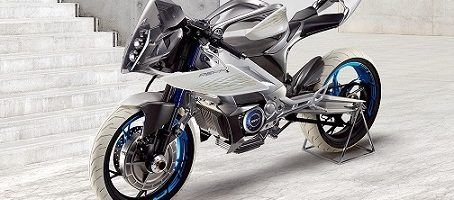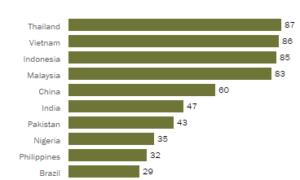Yamaha Motor or how to (intend to) lead the electric motorcycle industry

The Japanese motorcycle manufacturer seeks to become the leader in the new industry – but how does it fit with its leading gasoline-powered motorcycle business?
Finding a more sustainable future
1,545 million metric tons of CO2 were emitted by the U.S. motor industry in 2015, equivalent to 29% of total U.S. energy-related CO2 emissions for the same year[1]. The widespread agreement that these increasing numbers can lead to severe global consequences has prompted some motor companies to take important measures.
At the same time, congestion charges in some cities, uncertainty in fuel prices and environmental consciousness are some of the reasons that lead consumers to think about other means of transportation to avoid the traditional gasoline-powered vehicles.
We have witnessed the introduction of electric cars by recently founded automakers such as Tesla or by long-established ones such as BMW or Honda. However there has been given little attention to the use of electricity in motorcycles, which are a common means of transportation in several countries.
Figure 1: Percentage of households that have a motorcycle/scooter[2]
Yamaha Motor has been one of the first well-known motorcycle manufacturers to identify an opportunity within the electric motorcycle industry, which is still barely known in most countries.
Taking steps
The 61-year-old Japanese motor company announced during the 44th Tokyo Motor Show in November 2015 that it would introduce two models -PES2 and PED2- of electric motorcycles in 2016[3].
https://www.youtube.com/watch?v=SNz4RZ5b0Ak
The electric motorcycles present several advantages for the riders when compared to the traditional vehicles. These benefits include, among others, near-instant acceleration, not needing to go to the gas station, no oil, no exhaust and simpler machinery. And, what’s more, prices are similar to the ones set for traditional motorcycles.
The release date of the Yamaha motorcycles is yet to be confirmed but the company is sticking to the plan that it proclaimed six years ago: to lead the electric-motorcycle segment by 2020[4]. Following its Yamaha Motor Group Environmental Plan 2020, the firm seeks to increase environmental attractiveness by thinking about product development from the perspectives of the environment and customers[5].
But how does this plan fit with its traditional gasoline-powered (and high CO2-emitting) motorcycle business? Are the two types of motorcycles going to compete within the same company?
Apart from the above posed question, there is another element worth addressing: the potential scalability of the product. Other companies such as Zero Motorcycles, Harley-Davidson or BMW have already released similar electric-motorcycles, but none of them has created sufficient awareness so far. On the contrary, electric scooters –small motorcycles designed for short distances- have been successful in China, leading the electric scooter sales, with 9.4 of the 13 million units sold worldwide in 2013[6].
So, what’s next?
The benefits of the electric motorcycle are unquestionable but, as mentioned above, there are still several elements that must be clarified in order to understand the real potential for Yamaha within the electric motorcycle space.
Pulling some levers such as increasing congestion charges, introducing governmental subsidies to purchase electric motorcycles or limiting traffic for gasoline-powered motorcycles could help Yamaha increase its electric motorcycles sales. However, these elements are out of the firm’s reach.
Nonetheless, there are several other elements that the Japanese company could tackle to boost its electric motorcycle sales.
First, Yamaha could more broadly advertise both its Environmental Plan and the release of its two electric motorcycles. This would attract not only environmental conscious people but also current or potential Yamaha customers eager to try the new models.
Second, the firm could evaluate the possibility of entering the electric scooter market, which has proven successful in China. This type of motorcycle, due to its low price and its high reach in many countries -as seen in Exhibit 1- could allow Yamaha to more rapidly scale up its electric business. Once the electric scooters become successful, it could start upselling its electric motorcycles more broadly.
In the long-term, Yamaha could consider turning into more of an electric motor company, increasing the sales from its electric vehicles at the expense of its traditional motorcycles. It might seem controversial, but, if done the right way, wouldn’t Yamaha be able to create a competitive advantage, and even turn into the Tesla of motorcycles? I bet it could.
[Word Count: 780]
Sources:
[1] “How much carbon dioxide is produced by burning gasoline and diesel fuel?”, FAQ, U.S. Energy Information Administration. Accessed at http://www.eia.gov/tools/faqs/faq.cfm?id=307&t=11
[2] Jacob Pousher, “Car, bike or motorcycle? Depends on where you live” Pew Research Center, April 16, 2015. Accessed at http://www.pewresearch.org/fact-tank/2015/04/16/car-bike-or-motorcycle-depends-on-where-you-live/
[3] http://global.yamaha-motor.com/showroom/event/2015tokyomotorshow/sp/exhibitionmodels/, Models on Display at the 44th Tokyo Motor Show, Yamaha Motor official website
[4] Jonathan Welsh, “Electric Motorcycles: As Fast and Furious as Gas-Powered Bikes?” The Wall Street Journal, July 8, 2016. Accessed at http://www.wsj.com/articles/electric-motorcycles-as-fast-and-furious-as-gas-powered-bikes-1467903039
[5] Yamaha Motor Annual Report 2015. http://global.yamaha-motor.com/ir/annual/annual2015/ p. 27
[6] “The electric scooter market” Cleanrider, February 6, 2014. Numbers estimated by Navigant research. Accessed at http://cleanrider.com/electric-scooter-market/




Well done, Cristina! The electric motorcycle is a really cool concept, and it makes me wonder how big the potential market is. It’s interesting that Harley-Davidson and BMW have already released electric motorcycles, but haven’t had much success. I wonder how Yamaha will differentiate its product from the others. Based on the penetration of motorcycles/scooters, it seems logical to launch in Southeast Asia; I wonder where Harley and BMW launched and where Yamaha plans to launch.
While you bring up an interesting point, about Yamaha competing with itself for traditional and electric motorcycles, I don’t see this being an issue. If you think about Toyota, its Prius has had good success but its traditional cars continued to sell, perhaps to a different customer. I think that if there is interest for the electric motorcycle, then the two products can both exist. Since motorcycles are less-polluting than cars, are they still forced to pay congestion charges in cities that have them? If not, it might be difficult to change customer behavior for motorcycles, although it is a logical next step after electric cars.
Great post! As a motorcycle rider the allure of near-instantaneous acceleration is a very attractive one even if, as some members of our section have pointed out, they might sounds like an electric razor. I definitely think making a strong push to enter the Asian market would be a good way to experience the successes that companies like Harley-Davidson and BMW have failed to realize with their electric motorcycles.
With that said, I do wonder how how great of a positive environmental impact electric motorcycles could be. One challenge faced with the adoption of electric vehicles is the resulting greater energy demands on central power generation facilities (coal power plants, etc.)–the net result may be that we pollute less at the individual vehicle level but pollute more higher up the energy distribution network. Particularly in places like Asia where environmental controls on power plants are often less stringent than in the West, I wonder if the widespread adoption of electric vehicles like motorcycles could actually have a more deleterious effect on the global environment, and add the issues of environmentally-friendly battery disposal and pollution from battery precursor mining to the mix.
Interesting article! What I find most interesting, and related to the previous comment, is the fact that Harley Davidson and BMW have already launched electric motorcycles in their market. I would perhaps argue that the lack of awareness created may be due to the fact that most BMW or HD consumers are people who do not necessarily use them for transport, but more of a social activity or as a hobby? If this were the case, couldn’t Yamaha position itself by providing electric motorcycles for the general day-to-day person who uses motorcycles as their main means of transport? To this end, the values that the brand would need to address would be different, and their efforts may have to be focused on developing technology that could address issues that this particular market could value, for example cost efficiency.
As previous comments have noted, the market for motorcycles is a peculiar one. The culture is one that prizes a DIY approach to motorcycle maintenance (I could here cite Zen and the Art of Motorcycle Maintenance). To convert the core motorcycle user to electric motorcycles to me seems to be a difficult if not unrealistic task (as a motorcyclist myself). Rather, I would be interested in how the technology could bring in non-riders to the category. For example, motorized bicycles have become a favorite of deliverymen in New York and many other professions in China. In addition, tip-proof motorcycles have recently been introduced to the market, lowering the barrier to entry for many would-be riders who are afraid of the 2-wheel format.
Regardless of the marketing feasibility of the electric motorcycle program, I fail to see the environmental uplift of the project. Motorcycles are relatively efficient given their low weight profile, and as such do not represent major sources of green house gas emissions. I worry that pursuing this segment may not lead to any meaningful environmental change.